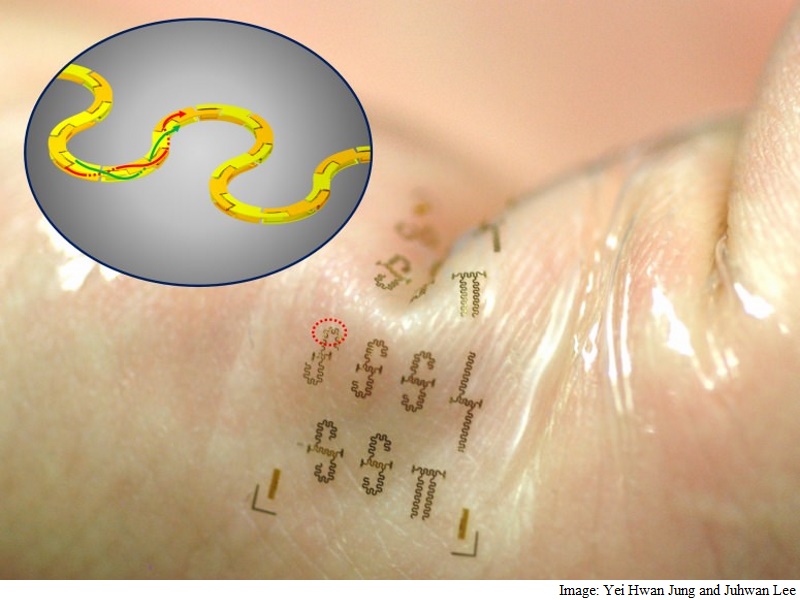- Home
- Wearables
- Wearables News
- New Wearable Circuits Could Revolutionise Internet of Things
New Wearable Circuits Could Revolutionise Internet of Things

Led by Zhenqiang "Jack" Ma from University of Wisconsin-Madison, the team developed the new stretchable integrated circuits taking inspiration from twisted-pair telephone cables. They contain, essentially, two ultra-tiny intertwining power transmission lines in repeating S-curves.
This serpentine shape - formed in two layers with segmented metal blocks, like a 3D puzzle - gives the transmission lines the ability to stretch without affecting their performance, said the study, published recently in the journal Advanced Functional Materials.
It also helps shield the lines from outside interference and, at the same time, confine the electromagnetic waves flowing through them, almost completely eliminating current loss. The stretchable integrated circuits can operate at radio frequency levels up to 40 gigahertz.
Unlike other stretchable transmission lines, whose widths can approach 640 micrometres, the new stretchable integrated circuits are just 25 micrometres thick. That's tiny enough to be highly effective in epidermal electronic systems, among many other applications.
"We've found a way to integrate high-frequency active transistors into a useful circuit that can be wireless," said Ma.
The technology can serve as a platform for manufacturers seeking to expand the capabilities and applications of wearable electronics - particularly as they strive to develop devices that take advantage of a new generation of wireless broadband technologies referred to as 5G.
The new integrated circuits could be used in wearable electronics that adhere to the skin like temporary tattoos. Because the circuits increase wireless speed, these systems could allow health care staff to monitor patients remotely, without the use of cables and cords.
For the latest tech news and reviews, follow Gadgets 360 on X, Facebook, WhatsApp, Threads and Google News. For the latest videos on gadgets and tech, subscribe to our YouTube channel. If you want to know everything about top influencers, follow our in-house Who'sThat360 on Instagram and YouTube.
Related Stories
- AI
- iPhone 16 Leaks
- Apple Vision Pro
- Oneplus 12
- iPhone 14
- Apple iPhone 15
- OnePlus Nord CE 3 Lite 5G
- iPhone 13
- Xiaomi 14 Pro
- Oppo Find N3
- Tecno Spark Go (2023)
- Realme V30
- Best Phones Under 25000
- Samsung Galaxy S24 Series
- Cryptocurrency
- iQoo 12
- Samsung Galaxy S24 Ultra
- Giottus
- Samsung Galaxy Z Flip 5
- Apple 'Scary Fast'
- Housefull 5
- GoPro Hero 12 Black Review
- Invincible Season 2
- JioGlass
- HD Ready TV
- Laptop Under 50000
- Smartwatch Under 10000
- Latest Mobile Phones
- Compare Phones
- Vivo Y38 5G
- Nokia 235 4G (2024)
- Nokia 225 4G (2024)
- Nokia 215 4G (2024)
- Redmi Note 13 Pro+ 5G World Champions Edition
- Infinix GT 20 Pro
- Oppo A60
- Realme C65 5G
- Dell Alienware X16 R2
- Lenovo IdeaPad Pro 5i
- Realme Pad 2 Wi-Fi
- Redmi Pad Pro
- boAt Storm Call 3
- Lava ProWatch Zn
- Samsung Samsung Neo QLED 8K Smart TV QN800D
- Samsung Neo QLED 4K Smart TV (QN90D)
- Sony PlayStation 5 Slim Digital Edition
- Sony PlayStation 5 Slim
- Lloyd 1 Ton 3 Star Inverter Split AC (GLS12I3FWAEV)
- Voltas 1.5 Ton 5 Star Inverter Split AC (185V Vectra Elite)

















